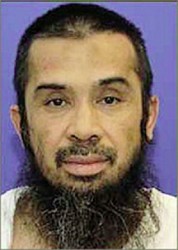WASHINGTON, (Reuters) – Hailed as a major success in the U.S. “war on terror,” the capture of Indonesian cleric Hambali if often touted by the U.S. intelligence community as evidence that harsh interrogation produces results.
But the U.S. Senate report on CIA interrogation methods released this week suggests that more mundane steps – email monitoring, a tip off from a CIA source and help from Thailand – may have been what brought down Hambali, head of militant group Jemaah Islamiah.
“Frankly, we stumbled onto Hambali,” the report quoted the head of the Central Intelligence Agency’s counterterrorism center in southeast Asia as saying in 2005.
Conflicting stories about the trail of clues that led investigators to Hambali illustrate one of the main disputes over the U.S. interrogation of terror suspects: Awful as it was, did it actually work?
Senior CIA officials told Congress, the White House and the Justice Department for years that a snippet of information from the brutal interrogation of senior al Qaeda operative Khalid Sheikh Mohammed led to Hambali’s capture.
Accused of planning the Sept. 11, 2001, attacks on the United States, Mohammed was repeatedly subjected to some of the CIA’s harshest methods after he was captured. He was waterboarded – a technique intended to simulate drowning – 183 times, and was slapped, grabbed and deprived of sleep, according to the Senate report.
Mohammed told CIA interrogators in early 2003 about a plan to have a former resident of Baltimore, Majid Khan, send $50,000 to southeast Asia to fund al Qaeda attacks.
The spy agency says that information helped investigators uncover a network of terror suspects in southeast Asia that led to Hambali himself. Hambali, also known as Riduan Isamuddin, was detained in Ayutthaya, Thailand, in 2003.
Described by former President George W. Bush as “one of the world’s most lethal terrorists,” Hambali is suspected of having been involved in plotting the Sept. 11 attacks and the bombing of a nightclub in Bali that killed more than 200 people. He has been held at the Guantanamo U.S. military prison in Cuba without trial since 2006.
TORTURE PLAYED “NO ROLE”

Although the CIA frequently presented the capture of Hambali as evidence that torture did produce valuable intelligence, the Senate report said that the harsh treatment of Mohammed, known as KSM, did not help catch Hambali.
In 2003, Hambali was among Asia’s most wanted men. The main go-between for the Jemaah Islamiah group of Southeast Asia and Osama bin Laden’s al Qaeda, Hambali was considered the only man from the region to win a place at al Qaeda’s top table.
His capture was seen as a coup for the Bush administration and Southeast Asian governments fearful of Jemaah Islamiah’s ability to launch attacks across the region.
The CIA gave “inaccurate representations regarding the capture of Hambali” in 18 documents sent to policymakers and the Department of Justice between 2003 and 2009, said the report, compiled by the Democratic majority on the Senate Intelligence Committee.
“A review of CIA operational cables and other records found that information obtained from KSM during and after the use of the CIA’s enhanced interrogation techniques played no role in the capture of Hambali,” the report said.
Before Mohammed gave up information about Khan during interrogation, the CIA was already assembling leads that would eventually bring it and Thai investigators to Hambali, the report said.
Some clues came from monitoring emails between al Qaeda and Khan, who was later captured in Pakistan. He gave Pakistani investigators details about al Qaeda’s links to Southeast Asia that eventually pointed to Hambali, the report said.





